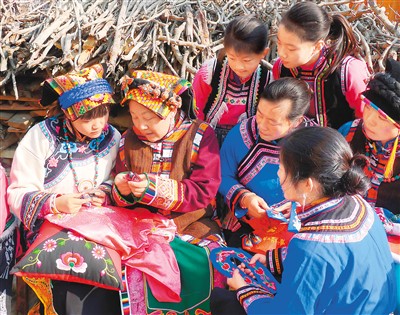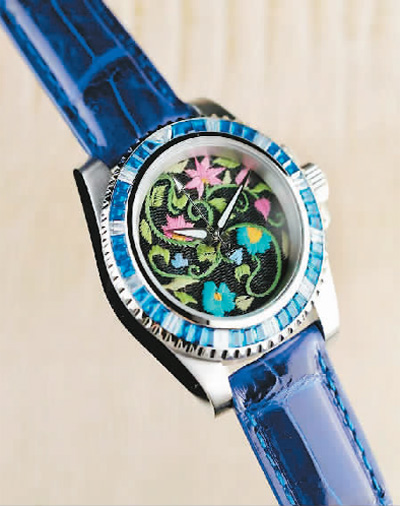Chinese embroidery artist takes ethnic cultural heritages to world
Yang Huazhen, in her 60s, is an inheritor of the national-level intangible cultural heritage of Tibetan embroidery. She has been dedicated to inheriting and developing the Tibetan and Qiang embroidery, which combines Qiang embroidery and Tibetan weaving and cross-stitch techniques, taking ethnic cultural heritages to the world.
Born in a small village inhabited by Tibetan and Qiang ethnic groups in Xiaojin county, Aba Tibetan and Qiang Autonomous Prefecture, southwest China's Sichuan Province, Yang inherited the embroidery craft from her family.

Yang Huazhen (2nd from left) instructs her apprentices on Qiang embroidery techniques. (Photo courtesy of the interviewee)
When she was 16, Yang became well-known in her village. Many brides-to-be would approach Yang, requesting her to embroider their wedding dresses and accessories.
Yang ran her photo studios and used to be a photojournalist. Over the past decades, her passion for Tibetan and Qiang embroidery has never waned. She has visited local artisans in villages inhabited by the Tibetan and Qiang people to learn about their traditional skills. After years of learning and practice, she has mastered Tibetan weaving and cross-stitch embroidery, as well as the different techniques of Qiang embroidery.
After a magnitude-8 earthquake struck Wenchuan county in the prefecture in 2008, Yang came up with the idea of helping the victims of the earthquake through an embroidery business.
In early 2009, Yang resigned from her job and put together a group of over 10 skilled embroiderers from Wenchuan and its surrounding areas to start her embroidery business with an initial fund of 30,000 yuan ($4,200) in Chengdu, capital of Sichuan.
One year later, Yang registered a company, which settled in an intangible cultural heritage industrial park established in Yingxiu township by Wenchuan county at the invitation of the county government.
To Yang, Tibetan and Qiang embroidery, as a craft, mirrors cultures that have been passed down for thousands of years. She has saved some traditional stitching skills from extinction.

Photo shows a piece of Qiang embroidery work of Yang Huazhen. (Photo courtesy of the interviewee)
Yang then set up her own studio in Yingxiu township to promote industrial development through the inheritance of intangible cultural heritages and strengthen the cultivation of intangible cultural heritage talent.
One of Yang's apprentices was recognized as a prefecture-level inheritor of Tibetan and Qiang embroidery in Aba Tibetan and Qiang Autonomous Prefecture in 2020.
Wang Sifang, another apprentice of Yang, became a provincial-level inheritor of Qiang embroidery in Sichuan in 2014. When Yang established a Qiang embroidery cooperative in Wenchuan in 2020, Wang was in charge of the research and development of Qiang embroidery products in the cooperative, as well as embroidery skill training for local women. Wang has offered training sessions for more than 4,000 people.
Yang's son, Feng Yang, also learned skills from his mother and was recognized as a city-level inheritor of Qiang embroidery in Chengdu in 2023.
Yang likewise recruited apprentices who are disabled women to help them achieve self-reliance. She has helped over 200 people with disabilities find jobs near their homes. In October 2022, Yang received the national honorary title of Outstanding Individuals for Helping Persons with Disabilities.
"Innovation is an inevitable path for the inheritance of intangible cultural heritages. Inheritors must keep up with the times and find innovative ways to integrate traditional crafts into modern-day life," Yang said.

Photo shows a watch Yang Huazhen developed for the Hong Kong Jockey Club. (Photo courtesy of the interviewee)
Yang has explored domestic and international markets with products featuring the cultural characteristics of Tibetan and Qiang ethnic groups and modern designs.
In 2014, an internationally renowned cosmetics company invited Yang to design patterns for two of its upcoming cleansers. As one product used green tea as the main ingredient, while the other combined eight plant extracts, Yang designed two patterns, with one featuring green tea flowers, which imply life and growth in nature, and the other featuring a Vajra Pestle, which symbolizes eternity and firmness in Tibetan culture.
The company was quite satisfied with Yang's design and decided to purchase the copyright of her design at a high price. Since then, Yang has pursued a path of cross-sector collaboration in authorizing copyrights for various intangible cultural heritages.
In June 2022, Yang made embroidery patterns for Universal Pictures by integrating elements of dinosaurs in Jurassic Park and World movies with typical elements of the Qiang ethnic groups.
"We continued partnering with Universal Pictures this year and designed over 10 embroidery patterns for the company's cartoon images such as Kung Fu Panda," she said.
Over the past years, Yang has collaborated with over 10 domestic and international brands for intellectual property licensing, making Tibetan and Qiang embroidery shine on the international stage.
She has established studios in several places in Sichuan, including Chengdu, Jiuzhaigou and Qionglai, as well as in several colleges. Many of her embroidery works won prizes at competitions at the national and provincial level. She has also won many national-level honorary titles.
"What belongs to an ethnic group also belongs to the world. We need to draw inspiration from traditional culture and string together traditional crafts in hidden corners like pearls," Yang said.
Photos
Related Stories
- Company in China's Henan sells wedding embroideries abroad
- Embroidery cooperative dedicated to inheritance of Kirgiz embroidery in NW China's Xinjiang
- Hard-of-hearing embroiderer from NW China's Xinjiang wins global recognition
- Trending in China | Reviving the craft of making hand-embroidered cuju balls
- Pic story of inheritor of Miao embroidery in Guizhou
Copyright © 2024 People's Daily Online. All Rights Reserved.









